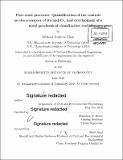Pore-scale processes : quantification of the controls on the transport of Ra and Cr, and development of a novel geochemical visualization tool
Author(s)
Chen, Michael Andrew.
Download1129586497-MIT.pdf (13.76Mb)
Alternative title
Quantification of the controls on the transport of Ra and Cr, and development of a novel geochemical visualization tool
Other Contributors
Massachusetts Institute of Technology. Department of Civil and Environmental Engineering.
Advisor
Benjamin D. Kocar.
Terms of use
Metadata
Show full item recordAbstract
Addressing soil contamination inorganic metals and metalloids remains a critical task for the continuing protection of human health globally. The dissolved concentrations of contaminants are controlled by a wide range of biogeochemical processes including oxidation and reduction by microbes, sorption to minerals and organic matter, and complexation with ligands in solution. Depending on the contaminant of interest, the importance of these different processes will widely vary, and the natural heterogeneity of soil systems all further frustrate modeling of contaminant transport. Recent studies have demonstrated that soil conditions vary at scales as small as individual soil pores, suggesting that the controls on contaminant transport also vary at that scale. Understanding the impact these pore scale processes have is necessary to build accurate conceptual models of contaminant fate. The work here explores these types of microscale processes through three different projects. The first project focuses on the sorption of radium, a naturally occurring radioactive material, to different minerals. Surface complexation modeling of Ra was able to replicate sorption experiments, but could not predict the impact of different solution conditions. The second project examines metal reduction via Fe (hyrd)-oxides, showing that bacteria may be able to form networks with semi-conducting Fe (hydr)-oxides. This means bacteria can access electron acceptors without physical contact, and will impact the cycling of redox sensitive metals at pore scales. The final project was the development in a microfluidic device that could be used to directly visualize biogeochemical processes at pore scales through x-ray fluorescence microprobe spectroscopy. The three projects, though focused on different systems, each reveal the importance of considering how microscale processes impact transport of contaminants.
Description
Thesis: Ph. D., Massachusetts Institute of Technology, Department of Civil and Environmental Engineering, 2019 Cataloged from PDF version of thesis. Includes bibliographical references (pages 123-140).
Date issued
2019Department
Massachusetts Institute of Technology. Department of Civil and Environmental EngineeringPublisher
Massachusetts Institute of Technology
Keywords
Civil and Environmental Engineering.